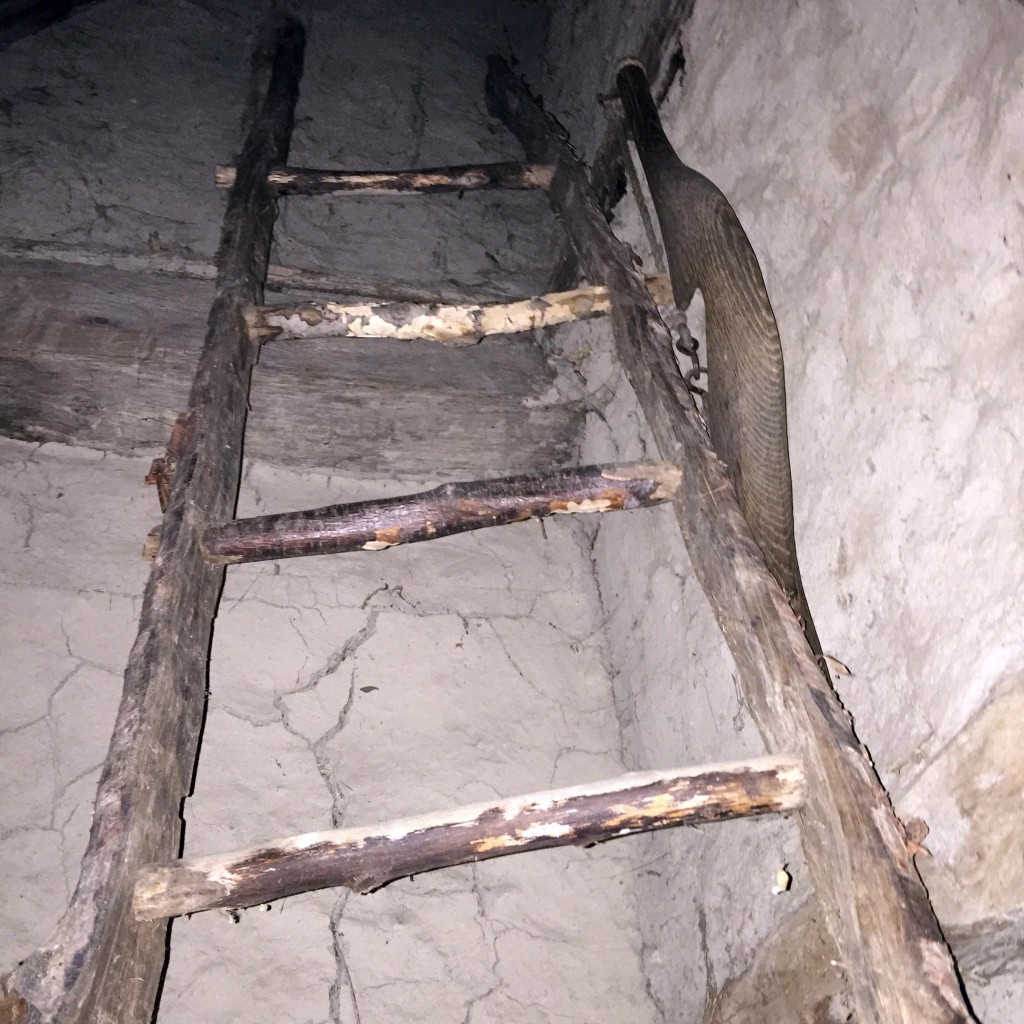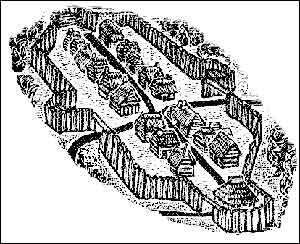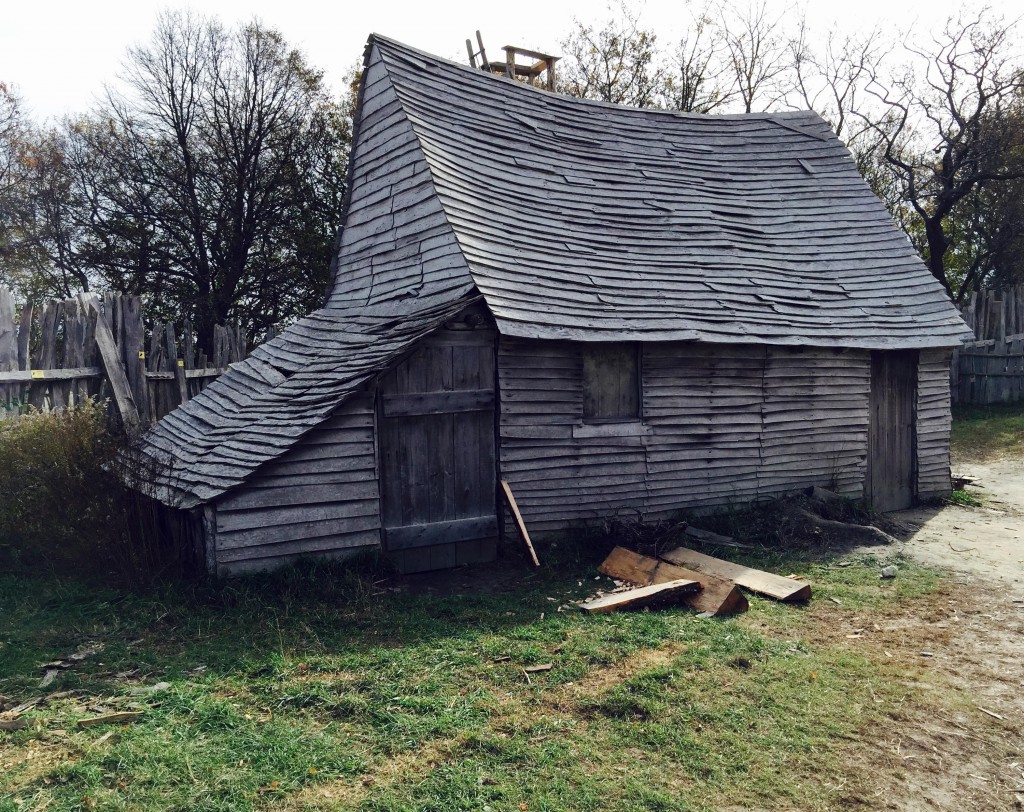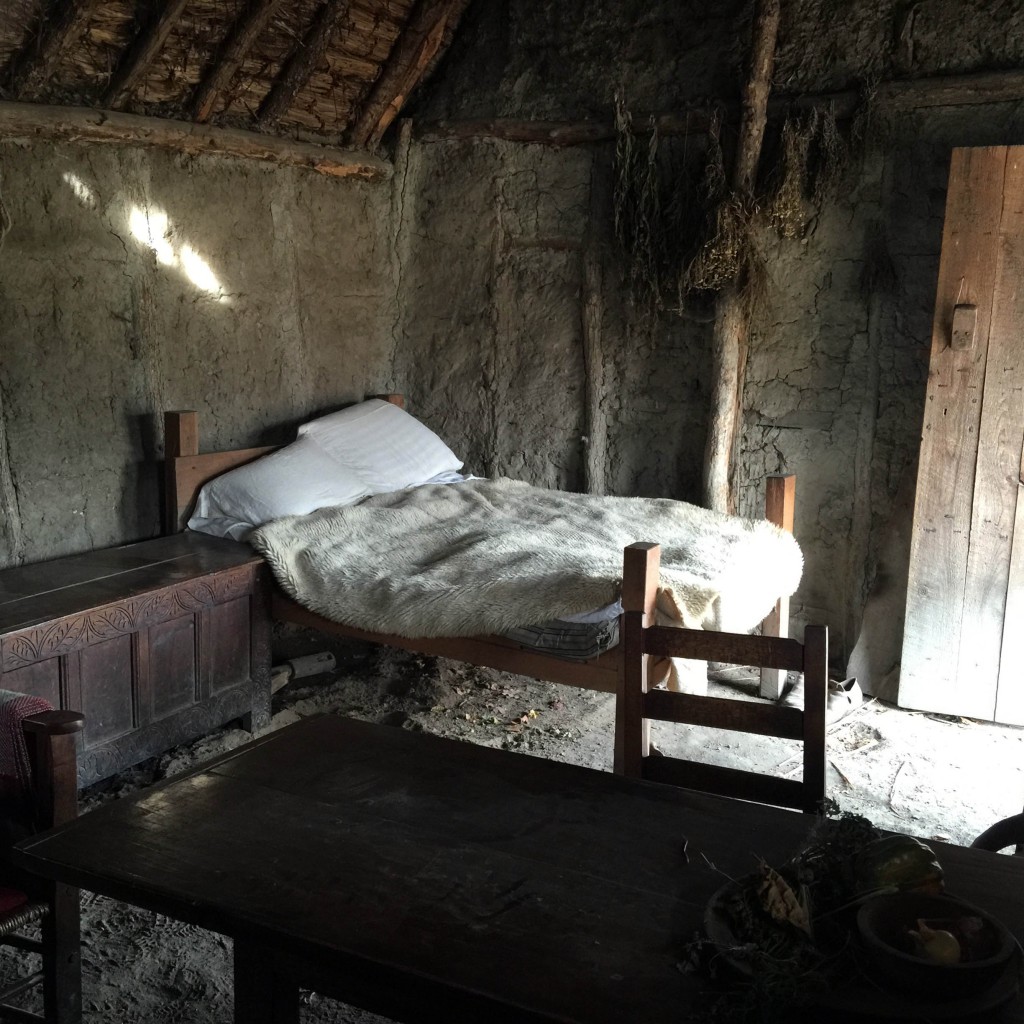Erin Taylor, February 2015
This post shares discussions and insights Kristin and I had after visiting Plimoth Plantation’s 1627 town site (November 2014). The good people at Plimoth Plantation have re-created the first settlement in painstaking detail, and it turns out, a Plymouth home — our AMB crime scene — wasn’t exactly as I had imagined it. The homes were smaller and with lower ceilings than I had figured (of course, I’m nearly six feet tall, so I have a skewed perspective). Also, the houses sat closer together than I had mentally plotted.
We spent two days at Plimoth Plantation, viewing the homes and speaking with reenactors. As we shared our thoughts about Martha’s murder based on what we saw there, it must be remembered this is a 1627 re-creation — in other words, twenty years before her death. By the 1640s, colonists had more tools and construction supplies, and homes were built under less dire circumstances. Within two decades of the Mayflower’s arrival, several towns were developing in the wider colony, but we assume the Bishops lived in Plymouth town proper because the Ramsdens and Winslows (Josiah, head) were their neighbors.
Our observations included how dark the homes are, even on the brightest of days. There are few candles, and windows are very small to keep the warmth inside the home. The home’s sole door was often kept open as a way to vent smoke. Because these 1627 homes were often one-room structures, we imagine that neighbors could see into (and certainly hear) activities taking place — in Plimoth Plantation, homes were no more than thirty feet apart. There is no record that a neighbor heard Martha screaming that July morning, so perhaps she was sleeping when the first cut occurred to her windpipe, effectively silencing her.
The main floor of a 1627 “middle class” family (not the Bradfords or Winslows, for example) had a marital bed raised from the floor, a dining table, and cooking fireplace. There were no meal preparation areas beyond the latter two and simple tableside benches. Many homes had but a couple of chairs. The floors were pressed earth. As mothers, we could envision toddlers in long gowns, struggling to stay upright over the lumpy ground. Many homes had a shelf attached to the wall where the family pot and plates resided. Books were rare, although I spoke to Edward Winslow’s servant (or, rather, a reenactor) who said her master brought over a trunk full of books that he shared with neighbors. Certainly, there wasn’t much time for reading. It seemed that every woman I met that November was harvesting seed from dried plants, tending to the fire, or explaining she surely did not know how to use the autofocus camera feature for a tourist’s quaint shot.
There was also not an abundance of clothes and, since we visited in autumn, it appeared they were wearing everything they owned. Enduring a Cape winter without central heating or polar fleece makes these people heroic on those grounds alone. The fireplaces, such as they were, were problematic. Some families fluted smoke out of the home through the roof, but others chose indirect ventilation techniques in an effort to maintain the heat. These homes could quickly fill with smoke, forcing the inhabitants to open doors and fan the space.
In these one-room dwellings, all interior family life took place: cooking, eating, sleeping, mending, the making and raising of babies. We were, naturally, especially interested in where children slept. We never encountered a Plimoth Plantation home in which bedding was placed in the loft. These spaces, instead, were used for storage of food supplies, tools, and construction supplies. Perhaps, by 1648, these spaces had evolved to include a sleeping nook for children, but when we asked numerous reenactors if children ever slept in the loft, we got dubious looks. Instead, children’s bedding was often a futon-like mattress that was placed on the floor at night and stored in a corner or on the marital bed during the day.

1627 replica ladder into loft space where grains and tools are kept. The entrance to the loft was often at the front door entrance.
This only confounds our re-creation of Martha’s murder and, fair warning, these next paragraphs will be graphic. It also speaks to the great advocacy Kristin and some readers have done urging me to reconsider how the murder happened.
The coroners and Rachel Ramsden both testified that Martha was found in the “upper chamber,” lying on her left side. My earlier assumption had been that Martha slept in the loft with, at least, her older sister, and was murdered there, likely while she slept. Now, we are considering the more typical sleeping arrangement where the girls all slept downstairs. As we discuss the logistics of the home and the scant evidence we have, we conclude Martha must have been out of bed when she was killed. Perhaps, Martha was on the first floor when her mother came after her. Then, in an attempt to hide the evidence, Alice places Martha in the loft.
If, however, she was killed downstairs…there are a few unresolved matters: One, the recorded evidence only speaks of the blood at the foot of the ladder — no mention of blood on Alice or in the main room. (Read the coroners’ inquest here.) This may well mean that blood was present, simply not documented. However, several deep cuts to anyone’s throat will produce immediate and copious blood flow and spray, including on the attacker. It seems odd that Rachel never mentioned seeing a bloody Alice.
Secondly, Martha and the knife were found in the upper chamber. This means Alice had to carry the literal dead weight of a child — likely more than 30 pounds — as well as the knife, up a ladder and place them there. Now certainly, this was feasible as heavier items were kept in these lofts. To me, it seems this would be a task commonly done by men because of the upper body strength required. (If we only knew where Richard was that morning and in what condition.) But, colonial women were likely a hardier breed than today’s American woman. Nonetheless, as evidenced by these pictures, it would take a lot of strength and balance to deposit a small body in the loft – the ladder is a lean-to and the space is small. Because of how the ladder leans against the sturdier wall (instead of the loft entrance), one must turn with the load and then deposit it into the loft, navigating an empty space of about two feet.
The flooring of the upper chamber is slotted and, horrifically, much of Martha’s blood would have dripped down to the floor below if bedding or straw were not present to absorb it. This can account for some of the blood found at the foot of the ladder. But, we wondered, why put such effort into hiding the body only then to immediately confess? Perhaps, Alice thought she could hide what she had done, but the moment she was interrogated, she knew the gig was up. We must remember that Alice told Rachel she should look to the upper chamber. In other words, she at least admitted her child was dead even before the coroners arrived.
If we commit to the premise that Martha was murdered in the loft, we have to wonder, “Why was she there?” Perhaps, she was doing something naughty, poking holes in a grain bag with a swiped knife and her mother caught her. An unholy rage took over Alice and she killed Martha. We know Rachel testified that, “She saw the child abed asleep.” I obviously made the assumption that Martha slept in the loft in which her body was found. But Kristin (as well as at least one of our readers) thinks the girls’ bed would have been downstairs — regardless of where the murder actually occurred.
A final scenario places Alice’s homicidal rage (or psychotic delusion) smoldering downstairs. Something then sets her off and she chases poor Martha into the loft. This does not explain — explain well, at least — the blood at the foot of the ladder. If Alice made the first cut there, as Martha attempted to scramble up the ladder (and why didn’t the child run our the front door instead?), the injury was likely significant enough that Martha couldn’t have managed to get up the ladder after that. This would mean, instead, that Martha got all the way into the loft before her mother caught hold of her. How did a neighbor not hear her screaming and come by? We just can’t seem to find one scenario that debunks the feasibility of others.
Ideally, we would like a re-created home from 1648 Plymouth Colony to explore. Perhaps our readers can suggest a site to visit or readings that can provide this information. For now, our conclusions are these:
- The Bishops lived in a one- or two-room home with neighbors nearby.
- Alice had a good enough relationship with Rachel Ramsden and the Winslows to ask for buttermilk.
- The three girls slept downstairs, likely sharing a bed. Perhaps, Abigail had been placed in a servantship with another family and maybe Damaris was still nursing and, therefore, bedding with her mother.
- The upstairs loft did not have a staircase but only a lean-to ladder. The loft space served as storage for tools and food supplies.
- There was likely a great deal of blood evidence not recorded and this would be helpful in understanding more about the murder.
- Lifting a dying or dead child with one arm — because the other arm is climbing the ladder — is an arduous task for many women.
Kristin has asked, more than once, why I care so much — the sequence of the day, determining where Martha slept, navigating a ladder with a heavy load. It’s a Sisyphean task for me. I’m likely never to have more “crime scene” evidence and witness testimony, but I certainly wish I did. For me, these things speak to motive and where my ultimate, unanswerable question remains, “Why did Alice murder Martha?”






Fascinating, and well done! 🙂 Knowing the details of how the house was set up certainly leads to more questions. If the house was so dark, and the ladder to the loft was behind the door, then how did Rachel notice the blood at the foot of the ladder? I am thinking now that perhaps Alice was indeed covered in blood and that this is what made Rachel immediately suspicious, especially when she didn’t see Martha. Alice could have easily covered up the blood at the foot of the ladder by simply throwing more dirt over it, so perhaps Rachel came back earlier than expected and interrupted Alice attempting to cover up the crime. There may be no mention of Damaris because maybe she was with her father??? Or alternatively, maybe the motive for killing Martha was if Martha had attacked Damaris in some way in a fit of jealousy??? Given the amount of blood at the ladder, it seems to make sense that that is where she was killed. How high is the loft from the floor? Could Alice have moved the ladder from the wall to the loft entrance to more easily place Martha there?
Thanks Diane — you always bring a critical eye to the AMB story! We always wish we just had a few more pieces of evidence or testimony. Because it was a summer morning, it’s possible the front door was open allowing light to come in. From what we could see, one could still navigate the ladder if the door was open because there is a very small alcove at the entrance. What we need is a 1648 house to be more certain.
Damaris would have been still nursing likely so I don’t know why she would have been with Richard but, again, that’s a possibility. As well as where was Abigail? The loft is probably 7-9 feet from the floor so it’s not possibly to just look up into it without going up the ladder some. Yes, she could have leaned the ladder against the actual loft entrance but the alcove was so small in the homes we saw that it would be difficult to then navigate the first few steps of the ladder (because they would be butted up against the wall against which the front door would open) — especially holding a child. If only we could hire the FBI and CSI!:
Ah… I thought Damaris was about 2 yrs old or so, so thought it possible she could have been with her father. It’s just really odd that Rachel indicates that Martha was in the bed, but makes no mention of Damaris. I’m thinking that perhaps Abigail was already with the Churchills, or maybe she was at a neighbors house to play. I had thought too that the ceilings were not high so assumed that the loft was closer to the ground than 7-9 ft. That certainly does it make it difficult to haul a 4 yr old up a ladder with one arm. Unless Alice sent Martha up there on her own, either to fetch something, to play, or as punishment, and the blood on the ground was what had seeped through the slats in the floorboards??? As to motive, if Alice “snapped” it could have been over something as trivial as Martha awoke from her nap and Alice discovered that Martha had wet the bed. She sent Martha to the loft as punishment or to get her out of the way, Martha started crying, Alice lost her patience and grabbed the knife from her waistband and cut her throat to stop the crying. The houses were close together and the door may have been open, yet no one heard Martha scream. If Martha was just crying and then suddenly stopped then perhaps the neighbors wouldn’t have noticed anything abnormal in that. Given the details about the house and proximity to neighbors, it seems unlikely that this was premeditated murder if Rachel was due to return with the buttermilk any minute. Sorry for the long posts…! your website just piqued my curiosity, and now I’m embroiled in this mystery too! 😉
I don’t know that we can assume the neighbors were close. The husband of Rachel Ramsden was brought to court just one year later for keeping his family too far in the woods. Perhaps Rachel lived the furthest out with Alice’s home being “on the way to town”. Perhaps that is why she stopped in on Alice in the first place, to see if she needed anything from their neighbors or town since Rachel was going that way.
Yes Sheree, we’d looked at Joseph Ramsden and his habit of living in the woods. What we were looking at was the proximity of homes in Plymouth town proper. IOW, we thought that a neighbor might have heard a scream or scuffle. Although we have no evidence of this. At this time, Rachel likely did not live too far from the town because we have to consider how she would have got there besides walking, maybe she was staying with her parents? We simply don’t know the exact location of the Bishop home within Plymouth Colony..along with a lot of other missing evidence! 🙂
I too am a many greats granddaughter of Alice. This case is fascinating for many reasons…the horror, the tragedy, the history, and it must be said, for the mystery. I do not believe one can be absolutely certain from the facts we have that Alice or Alice alone is guilty. There are too many questions. Rachel said when she came back with the buttermilk that Alice was “sad and dumpish”. There is no mention of blood on Alice. The blood at bottom of the ladder…remember it was summer, so the door was probably surely open. Light could have easily illuminated the area where the blood was seen. Again, we can get an idea of the house from those at Plymouth Plantation, but an idea only. The Bishop house could have been as much as twenty years ahead. We don’t know how the design of the space could have been different. Even larger. And, I don’t think it out of the question that the children “could have” slept in the loft. But again, they may have, they may have not. However, there is mention (and forgive me, I don’t remember where) of Martha being nearly unclothed or naked. This remark was made as if it added to the fiendish quality of the murder. This comment leads me to believe that Martha’s body was not found in or near her bed or bed chamber. If she had been found in her shift in or near where she slept, being found in her shift would not bein any way remarkable. Martha probably did sleep downstairs.
There is also the mystery of Martha herself. She knows Rachel is coming back with the retrieved buttermilk, but chooses this moment to kill her daughter? Then she admits to killing her daughter, says she did it, yet says she has no memory of the murder? It makes no sense. It actually kept me awake last night.
The blood at the bottom of the ladder again. If who ever slit Martha’s throated it while the girl was standing, if she was close to the loft opening and facing it or just to the side of it, the spurting blood could easily have fallen to the bottom of the ladder down below, or once she was down and the blood pooled, it could have dripped down over the edge of the opening in the loft.
One last thing…Damaris named one of her daughters Alice. If I had been raised to think my mother brutally killed my sister, I doubt I would have done the same. One could argue naming her daughter Alice shows she forgave mother, but you could also argue it shows an understanding, an almost defiant stance against her mother’s presumed guilt.
More good questions Sheree! Kristin and I have recreated the crime, in multiple home spots, many times and we have the same questions. We agree that the 1648 home’s layout could be very different from the recreated homes we saw, ca. 1627. The fact that Martha only wore a shift did not seem suspicious to me. Boys and girls, until the were at the age of doing chores outdoors, often wore nightshifts throughout the day, especially during warm months, as it made toileting easier and cut down on laundry. I have countless blood spatter and splatter questions — the problem is we have no new evidence. It appears as if the coroners did not record much of what they saw in the home, mainly because Alice confessed almost immediately. And these coroners were simply colony men with no medical or criminal investigation experience.
Now that’s something I hadn’t thought of…that Damaris named one of her daughters Alice…why would she do that? Curious…